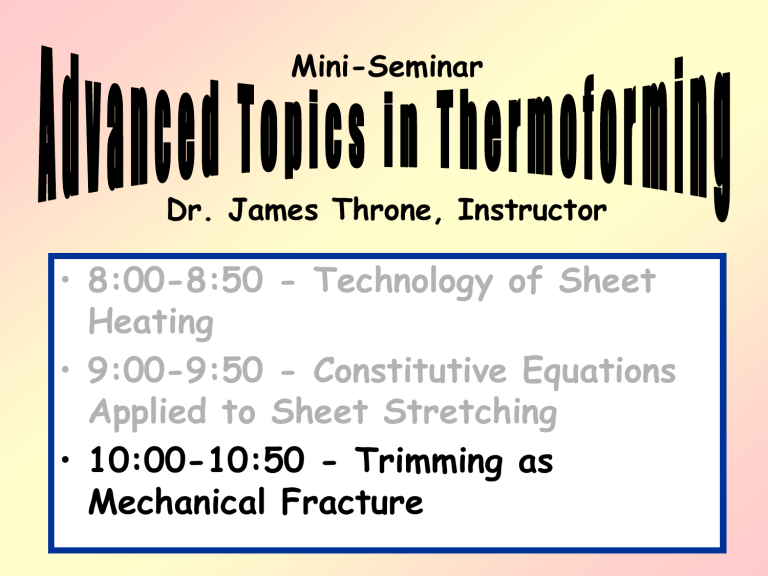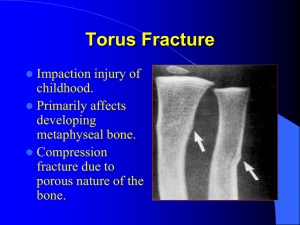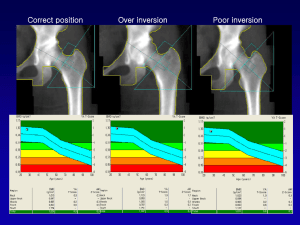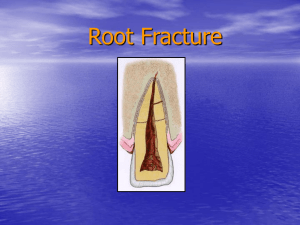Mini-Seminar Advanced Topics in Thermoforming

Mini-Seminar
Dr. James Throne, Instructor
• 8:00-8:50 - Technology of Sheet
Heating
• 9:00-9:50 - Constitutive Equations
Applied to Sheet Stretching
• 10:00-10:50 - Trimming as
Mechanical Fracture
Mini-Seminar
Advanced Topics in Thermoforming
Part 3: 10:00-10:50
Trimming as Mechanical
Fracture
Let’s begin!
Mini-Seminar
Advanced Topics in Thermoforming
• All materials contained herein are the intellectual property of Sherwood Technologies, Inc., copyright
1999-2006
• No material may be copied or referred to in any manner without express written consent of the copyright holder
• All materials, written or oral, are the opinions of
Sherwood Technologies, Inc., and James L. Throne,
PhD
• Neither Sherwood Technologies, Inc. nor James L.
Throne, PhD are compensated in any way by companies cited in materials presented herein
• Neither Sherwood Technologies, Inc., nor James L.
Throne, PhD are to be held responsible for any misuse of these materials that result in injury or damage to persons or property
Mini-Seminar
Advanced Topics in Thermoforming
• This mini-seminar requires you to have a working engineering knowledge of heat transfer and stress-strain mechanics
• Don’t attend if you can’t handle theory and equations
• Each mini-seminar will last 50 minutes, followed by a 10-minute “bio” break
• Please turn off cell phones
• PowerPoint presentations are available at the end of this seminar for downloading to your memory stick
Mini-Seminar
Advanced Topics in Thermoforming
• For those concerned about hearing the plenary speaker at 1100 hours, please be assured that this miniseminar will end promptly at 1050 hours…
• And, if for some strange reason, it doesn’t, please feel free to leave…
• THERE WILL BE NO FINAL!
• You can download all PPTs at the end of this section
Part 3: Trimming as Mechanical Fracture
Outline
• Fundamentals
• Fracture mechanics
• The mechanics of trimming
• Trimming accuracy
• Thin-gauge trimming
• Heavy-gauge trimming
Part 3: Trimming as Mechanical Fracture
What is Trimming?
• Trimming is semi-controlled mechanical breaking
• The objective is to separate the formed part from the web, skeleton, unformed plastic around it
• The methods of trimming are strongly dependent on sheet thickness
• Trimming can be manual or robotic, it can take place on the mold surface or in a remote fixture
Part 3: Trimming as Mechanical Fracture
Traditional trimming methods
• Manual - knives, serrated for foam
• Routers - hand-held, table-mounted fixed- position, multi-axis
• Band saws
• Circular saws - stationary, hand-held small- diameter, toothless saws for foam
• Abrasive wheels
Part 3: Trimming as Mechanical Fracture
Traditional trimming methods, cont.
• Sharp-edged compression blades or dies - steel-rule, ground forged, machined
• Linear shear guillotines - one-sided, two-sided
• Flames
• Lasers
• Water jets
Part 3: Trimming as
Mechanical Fracture
Traditional
Trimming
Methods
Part 3: Trimming as Mechanical Fracture
Mechanics of Fracture
Three general fracture modes
• Mode I - tensile mode, fracture surfaces spread apart by stress
• Mode II - shear mode, fracture surfaces slide perpendicular to advancing crack
• Mode III - tearing mode, fracture surfaces spread by stress parallel to crack
Part 3: Trimming as Mechanical Fracture
Mechanics of
Fracture
Part 3: Trimming as Mechanical Fracture
Mechanics of Fracture
• Mode III is a shearing action. Guillotine cutting of heavy gauge sheet and punch-and-die cutting of thin gauge sheet are Mode III
• Mode I is a compressing action. In-place trimming of thin-gauge sheet is Mode I
Part 3: Trimming as Mechanical Fracture
Mechanics of Fracture
Force needed to initiate a crack is substantially less than theoretical cohesive strength of polymer
Cracks initiate at flaws or defects
Consider a polymer having a small crack a in length under plane stress (Griffith crack theory)
EG *
a
K
C
a where E is Young’s modulus and ...
Part 3: Trimming as Mechanical Fracture
Mechanics of Fracture
EG *
a
K
C
a
G* is the fracture energy, given as G* = 2(P+ g ) where P is the plastic work done during yielding, g is the surface energy of the polymer,
K c is the fracture toughness or stress intensity factor
Part 3: Trimming as Mechanical Fracture
Mechanics of Fracture
EG *
a
K
C
a
Polymers with low P/ g ratios are brittle
(PMMA~5)
Polymers with very high P/ g ratios are ductile
(vulcanized rubber ~ 500)
It is nearly always the case that the energy to initiate a fracture is far greater than that needed to sustain crack propagation
Part 3: Trimming as Mechanical Fracture
K c
Mechanics of Fracture is the fracture toughness or stress intensity factor. It is written as K c
= f( ,a ) or
K c
C
a
C depends on crack geometry and surface being fractured
Polymer
PS
HIPS
PE
K c
(1000 lb/in 3/2 )
19.8
104
31.2
PMMA 19.8
Part 3: Trimming as Mechanical Fracture
Mechanics of Fracture
An aside
• Nanoparticles have initial sizes substantially below the Griffith crack criterion
• As a result, theoretically, fracture is unlikely to initiate on a nanoparticle
• Meaning that, theoretically, nano-filled polymers should have impact strengths equal to those of the polymers themselves
• The functional word here is “theoretically”
Part 3: Trimming as Mechanical Fracture
Mechanics of Trimming
Five general mechanisms
1. Mode I
In-plane unaxial compression
(die-cutting)
Part 3: Trimming as Mechanical Fracture
Mechanics of Trimming
Five general mechanisms
2. Mode III antiplane pure shear
(nibbling, shear cutting, punch and die)
Part 3: Trimming as Mechanical Fracture
Mechanics of Trimming
Five general mechanisms
3. Abrasion or abrasive cutting (grinding, filing,buffing, water jet cutting)
Part 3: Trimming as Mechanical Fracture
Mechanics of Trimming
Five general mechanisms
4. Brittle tensile fracture (routing, drilling, sawing)
Part 3: Trimming as Mechanical Fracture
Mechanics of Trimming
Five general mechanisms
5. Thermal
(hot knife, hot wire, laser cutting)
Part 3: Trimming as Mechanical Fracture
Trim Tolerance Limitation
• Local polymer shrinkage
• Polymer morphology
• Time-dependent part shrinkage after trimming
• Ductility of polymer
• Fixture/part rigidity
• Part temperature variation at trim line
• Registry accuracy
Part 3: Trimming as Mechanical Fracture
Trim Tolerance Limitation, cont.
• Trim die temperature variation
• Part thickness, thickness variation
• Allowable wall thickness variation at trim line
• Die gap setting temperature v. trim die temperature
• Clamp frame stiffness
• Die flexing during trimming
Part 3: Trimming as Mechanical Fracture
•
•
•
•
•
•
•
Factors in Selecting a Trimming Technique
Sheet gauge
Part size
Number of parts
Overall draw ratio
Nonplanar nature of trim line
Cut surface roughness tolerance
Dimensional tolerance
Part 3: Trimming as Mechanical Fracture
•
•
•
•
•
•
Factors in Selecting a Trimming Technique, continued
Required speed of trimming
Extent of fixturing
Number of secondary operations [drilling, machining]
Skill of operator/pressman
Availability of desired trim equipment
Availability of resharpening methods
Part 3: Trimming as Mechanical Fracture
•
•
The mechanics of trimming depends on the sheet gauge
Thin-gauge trimming
Heavy-gauge trimming
Part 3: Trimming as Mechanical Fracture
Thin Gauge
Steel rule die cutting
1. In place, on the mold, in-situ
2. In machine, separate station
3. In line, separate machine
Part 3: Trimming as Mechanical Fracture
1. In-place trimming with steel-rule die
Part 3: Trimming as
Mechanical Fracture
Thermoforming –
1. Form and inplace trimming
[GN]
Part 3: Trimming as Mechanical Fracture
2. In-machine, usually with stacker
Part 3: Trimming as Mechanical Fracture
3. In-line trimming with canopy punch and die
Part 3: Trimming as Mechanical Fracture
Thin-gauge trimming
Primary methods
1. In-plane uniaxial compression or die-cutting
Cutting stress, = E e , where E is elastic tensile modulus and e is extent of strain
Solid compressibility is reciprocal of bulk modulus,
B which is related to the elastic tensile modulus:
E = 3B(1-2 n ) where n is Poisson’s ratio, 0.3 < n <
0.4
Part 3: Trimming as Mechanical Fracture
Thin-gauge trimming
Primary methods
2. Mode III antiplane pure shear or punch-anddie cutting
Shearing stress, under shear force
= G e s
, where G is the modulus of rigidity or shear modulus and e s is strain
Shear modulus is related to tensile modulus:
G = E/2(1+ n ) where n is Poisson’s ratio, 0.3 < n <
0.4
Part 3: Trimming as Mechanical Fracture
Thin-gauge trimming
Primary methods – Compared
PA
HDPE n
Values for Poisson’s ratio
=0.33
n =0.35
PMMA
LDPE
Average n =0.35
n n
=0.33
=0.38
For average, E/G = 2.7, E/B = 0.9
Shear cutting force about 40% of that of compression cutting force (on average)
Part 3: Trimming as Mechanical Fracture
Thin-gauge trimming
Polymer response to compression cutting
Part 3: Trimming as Mechanical Fracture
Thin-gauge trimming
Polymer response to compression cutting of brittle polymers
Part 3: Trimming as Mechanical Fracture
Thin-gauge trimming
•
•
•
Compression cutting required force is function of
Trim length
Polymer type
Polymer temperature
•
• Trim die temperature
Sharpness of die
General equation:
F (force/unit length of trim) = a + b (polymer thickness)
Part 3: Trimming as Mechanical Fracture
Thin-gauge trimming
Various steel rule die designs
Curve D is for dulled version of cutter B
RPVC
PS
Part 3: Trimming as Mechanical Fracture
Thin-gauge trimming- 1
Steel rule die cutting force as function of cutter temperature, F = a + b(tk)
Polymer
(
Cutter
Temp o C) a
(lb f
/in) b
(lb f
/in 2 )
Force @
40 mils
(lb f
/in)
Pct
Reduction
_______________________________________________________________
HIPS 20 7.2 1231 56.4 -
HIPS 80 14.1 539 35.7 37
ABS
ABS
RPVC
RPVC
20
80
20
80
13.4
12.4
21.5
16.5
943
647
1078
746
51.1
38.3
64.6
46.3
-
25
-
28
Part 3: Trimming as Mechanical Fracture
Thin-gauge trimming- 2
Steel rule die cutting force as function of cutter temperature, F = a + b(tk)
Polymer
(
Cutter
Temp o C) a
(lb f
/in) b
(lb f
/in 2 )
Force @
40 mils
(lb f
/in)
Pct
Reduction
_______________________________________________________________
HDPE 20 19.5 917 56.2 -
HDPE
HoPP
80
20
80
25.1
23.7
26.0
486
934
503
44.5
61.6
46.1
21
-
24 HoPP
PET
PET
20
80
35.6
37.0
1258
989
85.9
76.6
-
11
PC
PC
20
80
39.0
32.9
970
835
77.8
66.3
-
15
Part 3: Trimming as Mechanical Fracture
Thin-gauge trimming- 1
Steel rule die cutting force as function of sheet thickness, cutter temp = 20 o C, F = a + b(tk)
Polymer a
(lb f
/in) b
(lb f
/in 2 )
Force @
20 mils
Force @
40 mils
Force @
60 mils
(lb f
/in) (lb f
/in) (lb f
/in)
_______________________________________________________________
HIPS 7.2 1231 31.8 56.4 81.1
ABS
RPVC
PC
13.4
21.5
39.0
943
970
1078
32.3
43.1
58.4
51.1
64.6
77.8
70.0
86.2
97.2
PET 35.6 1258 60.8 85.9 111.1
Part 3: Trimming as Mechanical Fracture
Thin-gauge trimming- 2
Steel rule die cutting force as function of sheet thickness, cutter temp = 20 o C, F = a + b(tk) competitive packaging polymers
Polymer a
(lb f
/in) b
(lb f
/in 2 )
Force @
20 mils
(lb f
/in)
Force @
40 mils
(lb f
/in)
Force @
60 mils
(lb f
/in)
_______________________________________________________________
HIPS 7.2 1231 31.8 56.4 81.1
HoPP
RPVC
PET
23.7
21.5
35.6
934
1078
1258
42.4
43.1
60.8
61.6
64.6
85.9
79.7
86.2
111.1
Part 3: Trimming as Mechanical Fracture
Force required to compression-trim thin-gauge packaging plastics
Plastic
HIPS ABS RPVC PC PET hoPP
120
100
80
60
40
20
20 40 60
Based on experimental data, plotted as Force/inch =a + b(thickness)
Part 3: Trimming as Mechanical Fracture
Thin-gauge trimming -Example
Calculate the force required to die-cut 10-in x
10-in trays, 9-up from 40 mil sheet of a)
HIPS, b) PET
Trim length- 4 x 10 x 9 = 360 inches a) HIPS - 56.4 lb f tons
/in x 360 = 20,304 lb f b) PET - 85.9 lb tons f
/in x 360 = 30,924 lb f
= 10
= 15.5
Part 3: Trimming as Mechanical Fracture
Heavy-gauge trimming
• Hand-trimming using saws, routers
• Automated, programmable multiaxial routers that include saws, drills
Part 3: Trimming as
Mechanical Fracture
Heavy-gauge trimming
• Within the past decade, CNC-driven multi-axis routers, borrowed from the woodworking industry, have become standard fare for high quality part production in heavy-gauge forming.
• 5-axis router - Quintax
Part 3: Trimming as Mechanical Fracture
Heavy-gauge trimming
• “Three-Dimensional Trimming & Machining - The
Five Axis CNC Router”, K.J. Susnajara,
Thermwood Corporation, 1999
• Contents
– Machine Basics
– CNC Router Design
– Holding the Part
– Tooling
– Programming
– Accuracy
– Economics
Part 3: Trimming as Mechanical Fracture
Accuracy
Heavy-gauge trimming
• First Layer
– Single v. multiple axis repeatability
– Absolute positioning accuracy - Single v. multiple axis
– Loaded v. unloaded repeatability, accuracy
– Machine considerations
• Lead screw backlash
• Rotary resolution of servomotor
• Encoder resolution and stepping interval
• Rail linearity
• Machine alignment [square and perpendicular]
Part 3: Trimming as Mechanical Fracture
Accuracy
Heavy-gauge trimming
• First Layer
– Machine Design
• Lead screw backlash
• Rotary resolution of servomotor
• Encoder resolution and stepping interval
• Rail linearity
• Machine alignment [square and perpendicular]
• Head alignment - effect of crashes
• Head worm spur gear tooth accuracy, backlash
Part 3: Trimming as Mechanical Fracture
Accuracy
Heavy-gauge trimming
• Second Layer
– Servo System Tracking
– Inertia during acceleration, deceleration
– Vibration, push-off, flexing
– Speed
– Tool length accuracy
– Tool-to-collet tightening
– CAD/CAM interpretation of curves [splines]
– Trimming of part v. computer trim path
Part 3: Trimming as Mechanical Fracture
Accuracy
Heavy-gauge trimming
• Third Layer
– Overall part size variability
• Molding temperature
• Raw material formulation
• Cooling characteristics
– Polymer flexing under trim load
– Bridge flexing during carriage movement
– Dynamic flexing and bending v. speed
– Polymer reaction to push-off
– Bending, flexing of tool under load
Part 3: Trimming as Mechanical Fracture
Accuracy
Heavy-gauge trimming
• Third Layer
– Thermal exansion, contraction
• Different materials in router
• Polymers being trimmed
• Tool dimensional change during trimming
– Polymer warping, distortion during trimming
– Trim direction v. “grain” in polymer
Part 3: Trimming as Mechanical Fracture
Accuracy
Heavy-gauge trimming
• Conclusion - Repeating an accurate
position in space is far easier than achieving that accurate position in space.
Part 3: Trimming as Mechanical Fracture
Heavy-gauge trimming
The mechanics of chip-breaking
[Saws, drills, routers, mills]
Chip
Cutter
Work
Part 3: Trimming as Mechanical Fracture
Heavy-gauge trimming
Factors Affecting Cutting Characteristics of Plastics
Part 3: Trimming as Mechanical Fracture
Heavy-gauge trimming
Multiple Edged Tool Cutting
Part 3: Trimming as Mechanical Fracture
Heavy-gauge trimming
Multiple Edged Tool Cutting
Tooth depth of cut, g is: g = V p sin f /U
V is the feed rate, p is the tooth spacing, U is the peripheral blade speed, U=pDN, D is the diameter of the cutting blade, N is the blade speed (RPM).
Part 3: Trimming as Mechanical Fracture
Heavy-gauge trimming
Multiple Edged Tool Cutting
The angle f is given as f = cos -1 [(h-b/2)/R] where h is the cut-off height or distance between the saw centerline and the bottom of the plastic sheet, b is the sheet thickness, R is the saw radius, R = D/2
Part 3: Trimming as Mechanical Fracture
Heavy-gauge trimming
Multiple Edged Tool Cutting
Feed rate, V, proportional to blade speed, N, and diameter, D
Feed rate, V, inversely proportional to tooth spacing, p
[Arithmetic holds for multiple-edge routers as well]
Part 3: Trimming as Mechanical Fracture
Heavy-gauge trimming
Drilling
Part 3: Trimming as Mechanical Fracture
Heavy-gauge trimming
Drilling
Depth of cut per drill tooth, d: d = (s/n) sin q /2 = (V/nN) sin q /2 n is number of teeth on drill (one or two), N is the drill speed, V is the axial feed rate, s is drill feed speed, s = V/N, and q is the point tooth angle
Part 3: Trimming as Mechanical Fracture
Heavy-gauge trimming
Effect of Drill Geometry on Drilling Conditions
Drill Parameter Drill Condition
Point angle
Rake angle
Rotational drill speed
Drill feeding speed
Relief angle
Helix angle
Shape of flutes
Work temperature
Cooling provisions
Nature of the hole
Part 3: Trimming as Mechanical Fracture
End of
Part 3
Trimming as
Mechanical Fracture
Part 3: Trimming as Mechanical Fracture
End of
Mini-Seminar
Mini-Seminar
Advanced Topics in
Thermoforming






